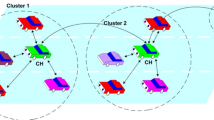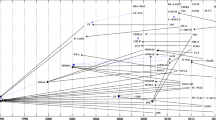Abstract
A vehicular ad hoc network (VANET) is a network in which vehicles acting as dynamic nodes communicate with each other. A VANET is a suitable piece of infrastructure for developing intelligent transportation systems. Stable communication within a VANET leads to enhanced driver safety and better traffic management. The clustering technique, which organizes similar vehicles into similar groups, is a possible method for improving the stability of connectivity within a VANET. In this paper, two new clustering algorithms suited to the dynamic environment of a VANET are proposed. The multi-objective data envelopment analysis clustering algorithm as a mathematical clustering model and the ant system-based clustering algorithm as a meta-heuristic clustering model are introduced as algorithms for VANETs. A comparative simulation study in a highway environment is presented as well to evaluate the introduced methods and compare them with the most commonly used VANET clustering algorithms. The results show that the proposed algorithms offer improved stability and runtime along with relatively better performance than existing algorithms. Furthermore, the results show that in the VANET environment, the mathematical clustering model proposed herein yields better results than the meta-heuristic algorithm.














Similar content being viewed by others
References
IEEE 802.11 TGP. (2010). Wireless LAN medium access control (MAC) and physical layer (PHY) specifications amendment 6: Wireless access in vehicular environments. IEEE 802.11p published standard. http://standards.ieee.org/getieee802/download/802.11p-2010.pdf.
Santos, R. A., Edwards, R. M., Seed, N. L. (2004). Supporting inter-vehicular and vehicle roadside communications over a cluster-based wireless ad-hoc routing algorithm. In Proceedings of the Winter International Symposium on Information and CommunicationTechnologies (WISICT’04), Trinity College, Dublin, 1–6.
Jain, A. K., Duin, R. P. W., & Mao, J. (2000). Statistical pattern recognition: A review. IEEE Transactions on Pattern Analysis and Machine Intelligence, 22, 4–37.
Han, J., & Kamber, H. (2006). Data mining: Concepts and techniques (Vol. 2, pp. 383–466). Amsterdam: Elsevier.
Hartigan, J. A. (1975). Clustering algorithms (pp. 74–129). New York: Wiley.
Kaufman, L., & Rousseeuw, P. J. (1990). Finding groups in data: An introduction to cluster analysis. New York: Wiley.
McLachlan, G. J., & Basford, K. E. (1988). Mixture models: Inference and applications to clustering. New York: Marcel Dekker.
McLachlan, G. J., & Krishnan, T. (1997). The EM algorithm and extensions. New York: Wiley.
Bezdek, J. C. (1981). Pattern recognition with fuzzy objective function algorithm. New York: Plenum Press.
Yang, M. S. (1993). A survey of fuzzy clustering. Mathematical and Computer Modelling, 18, 1–16.
Rawashdeh, Z. Y., & Mahmud, S. M. (2012). A novel algorithm to form stable clusters in vehicular ad hoc networks on highways. EURASIP Journal on Wireless Communications and Networking, 15, 1–13.
Aoki, M., & Fuji, H. (1996). Inter-vehicle communication: Technical issues on vehicle control application. IEEE Communications Magazine, 34, 90–93. doi:10.1109/35.544327.
Fan, P., Mohamadian, A., Nelson, P., Haran, J., Dillenburg, J. (2007). A novel direction-based clustering algorithm in vehicular ad hoc networks. In Proceedings of the transportation research board 86th annual meeting, Washington DC, United States.
Garg, M., Shyamasundar, R. K. (2004). A Distributed, clustering framework in mobile Ad Hoc networks. In Proceedings of the International Conference on Wireless Networks (ICWN’04), Las Vegas, 32–38.
Liu, X., Fan, Z., Shi, L. (2007). Securing vehicular ad hoc networks. In Proceedings of the second conference on international pervasive computing and applications, Birmingham, 424–429.
Wang, Y. X., Bao, F. Sh. (2007). An entropy-based weighted clustering algorithm and its optimization for ad hoc networks. In Proceedings of the third IEEE international conference on wireless and mobile computing, networking and communications.
Kabnurkar, A. (2001). Mathematical modeling for data envelopment analysis with fuzzy restrictions on weights. Doctoral Dissertation, Dep. of Industrial and Systems Engineering, Unive. Polytechnic Institute and State, Virginia.
Balaji, S., Sureshkumar, S., & Saravanan, G. (2013). Cluster based ant colony optimization routing for vehicular ad hoc networks. International Journal of Science & Engineering Research, 4, 26–30.
Gerla, M., & Tsai, J. (1995). Multicluster, mobile, multimedia radio network. Wireless Network, 1, 255–265.
Fan, P., Harran, G. J., Dillenburg, J., & Nelson, P. C. (2005). Cluster-based framework in vehicular ad- hoc networks. Adhoc-Now 2005, LNCS 3738 (pp. 32–42). Berlin: Springer.
Blum, J., Eskandarian, A., Hoffman, L. (2003). Mobility management in IVC networks. In Proceedings of the IEEE intelligent vehicles symposium, pp. 150–155.
Lin, C. R., & Gerla, M. (1997). Adaptive clustering for mobile networks. IEEE Selected Areas in Communications, 15, 1265–1275.
Baker, D. J., Ephremides, A. A. (1981). Distributed algorithm for organizing mobile radio telecommunication networks. In Proceedings of the second international conference on distributed computer systems, pp. 476–483.
Chatterjee, M., Das, S. K., & Turgut, D. (2002). WCA: A weighted clustering algorithm for mobile ad hoc networks. Cluster Computing, 5, 193–204.
Santos, R. A., Edwards, A., Edwards, R., & Seed, L. (2005). Performance evaluation of routing protocols in vehicular ad hoc networks. International Journal of Ad Hoc and Ubiquitous Computing, 1, 80–91.
Fan, P., Nelson, P., Haran, J., Dillenburg, J. (2006). An improved compound clustering algorithm in vehicular ad-hoc networks. In Proceedings of the ninth international conference on applications of advanced technology in transportation (AATT06), Chicago, IL, USA, pp. 424–430.
Fan, P., Sistla, P., Nelson, P. (2008). Theoretical analysis of a directional stability-based clustering algorithm for VANETs. VANET’08, San Francisco, California, USA, pp. 80–81.
Almalag, M. S., Weigle, M. C. (2010). Using Traffic flow for cluster formation in vehicular ad hoc networks. The 35th Annual IEEE Conference on Local Computer Networks, Denver, Colorado, USA, IEEE, 631-636.
Ramakrishnan, B., Rajesh, R. S., & Shaji, R. S. (2010). CBVANET: A cluster based vehicular adhoc network model for simple highway communication. International Journal of Advanced Networking and Applications, 2, 755–761.
Daeinabi, A., GhaffarPourRahbar, A., & Khademzadeh, A. (2011). VWCA: An efficient clustering algorithm in vehicular ad hoc networks. Journal of Network and Computer Applications, 34, 207–222.
Wolny, G. (2008). Modified DMAC clustering algorithm for VANETs. Proceeding Third Int (pp. 268–273). Washington, DC, USA: Conf. on Syst. and Networks Commun.
Zhang, Z., Boukerche, A., Pazzi, R. (2011). A novel multi-hop clustering scheme for vehicular ad-hoc networks. In Proceeding 9th ACM Int. Symp. on Mobility Manage. and Wireless Access, Miami, Florida, USA, pp. 19–26.
Thanassoulis, E. (1996). A data envelopment analysis approach to clustering operating units for resource allocation purposes. Omega, 24, 463–476.
Yin, X., Han, J., & Yu, P. S. (2007). Crossclus: User-guided multi-relational clustering. Data Mining and Knowledge Discovery, 15, 321–348.
Leonard, S. T., & Droege, M. (2008). The uses and benefits of cluster analysis in pharmacy research. Research in Social and Administrative Pharmacy, 4, 1–11.
Rege, M., Dong, M., & Fotouhi, F. (2008). Bipartite isoperimetric graph partitioning for data co-clustering. Data Mining and Knowledge Discovery, 16, 276–312.
Kim, J., Yang, J., & O’lafsson, S. (2009). An optimization approach to partitional data clustering. Journal of the Operational Research Society, 60, 1069–1084.
Po, R. W., Guh, Y. Y., & Yang, M. S. (2009). A new clustering approach using data envelopment analysis. European Journal of Operational Research, 199, 276–284.
Bojnec, S., & Latruffe, L. (2007). Measures of farm business efficiency. Industrial Management & Data Systems, 108, 258–270.
Sharma, M. J., & Yu, S. J. (2009). Performance based stratification and clustering for benchmarking of container terminals. Expert Systems with Applications, 36, 5016–5022.
Azadeh, A., Ghaderi, S. F., Tarverdian, S., & Saberi, M. (2007). Forecasting electrical consumption by integration of neural network, time series and ANOVA. Applied Math and Computation, 186, 1753–1761.
Marroquin, M., Pena, M., Castro, C., Castro, J., & Cabrera-Rios, M. (2008). Use of data envelopment analysis and clustering in multiple criteria optimization. Intelligent Data Analysis, 12, 89–101.
Schreygg, J., & Von Reitzenstein, C. (2008). Strategic groups and performance differences among academic medical centers. Health Care Management Review, 33, 225–233.
Colorni, A., Dorigo, M., Maniezzo, V. (1991). Distributed Optimization by Ant Colonies. In Proceeding of European conference on Artificial Life (ECAL91), Paris, France, Elsevier Publishing, pp. 134–142.
Deneubourg, J. L., Aron, S., Goss, S., & Pasteels, J. M. (1990). The self-organizing exploratory pattern of the Argentine ant. Journal of insect behavior, 3, 159–168.
Tsai, C. F., Wu, H. C., Tsai, C. W. (2002). A new clustering approach for data mining in large databases. In Proceedings of the international symposium on parallel architectures. Algorithms and networks (ISPAN’02), IEEE Computer Society, pp. 1087–4089.
Yang, X. B., Sun, J. G., Huang, D. (2002). A new clustering method based on ant colony algorithm. In Proceedings of the 4th world congress on intelligent control and automation, pp. 2222–2226.
Kuo, R. J., Wang, H. S., Hu, T. L., & Chou, S. H. (2005). Application of ant K-Means on clustering analysis. Computers & Mathematics with Applications, 50, 1709–1724.
Kuo, R. J., & Shih, C. W. (2007). Association rule mining through the ant colony system for National Health Insurance Research Database in Taiwan. Computers & Mathematics with Applications, 54, 1303–1318.
Kuo, R. J., Lin, S. Y., & Shih, C. W. (2007). Mining association rules through integration of clustering analysis and ant colony system for health insurance database in Taiwan. Expert Systems with Applications, 33, 794–808.
Sahoo, R. R., Panda, R., Behera, D. K., Naskar, M. K. (2012). A trust basedclustering with Ant Colony Routing in VANET. Computing Communication &Networking Technologies (ICCCNT), Third International Conference on, 1: 26–28.
Cooper, W. W., Seiford, L. M., & Tone, K. (2007). Data envelopment analysis: A comprehensive text with models, applications. Springer Science: References and DEA-Solver Software.
Witten, I. H., & Frank, E. (2005). Data mining: Practical machin learning tools and techniques (Vol. 2). New york: Elsevier.
Jafarian-Moghaddam, A. R., & Ghoseiri, K. (2011). Fuzzy dynamic multi-objective data envelopment analysis model. Expert Systems with Applications, 38, 850–855.
Jafarian-Moghaddam, A. R., & Ghoseiri, K. (2012). Multi-objective data envelopment analysis model in fuzzy dynamic environment with missing values. The International Journal of Advanced Manufacturing Technology, 61, 771–785.
Abdulhamid, H., Tepe, K. E., & Abdel-Raheem, E. (2007). Performance of DSRC systems using conventional channel estimation at high velocities. International Journal of Electronics and Communications, 61, 556–561.
Devore, J. L. (2011). Probability and Statistics for Engineering and the Sciences (8th ed.). Cengage Learning: Boston.
Author information
Authors and Affiliations
Corresponding author
Rights and permissions
About this article
Cite this article
Fathian, M., Jafarian-Moghaddam, A.R. New clustering algorithms for vehicular ad-hoc network in a highway communication environment. Wireless Netw 21, 2765–2780 (2015). https://doi.org/10.1007/s11276-015-0949-5
Published:
Issue Date:
DOI: https://doi.org/10.1007/s11276-015-0949-5




